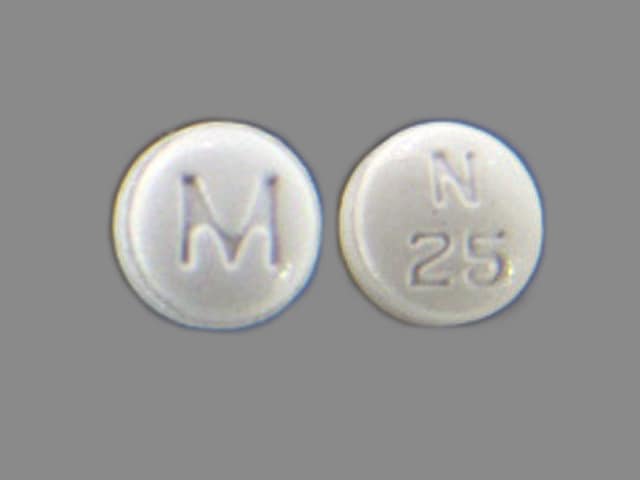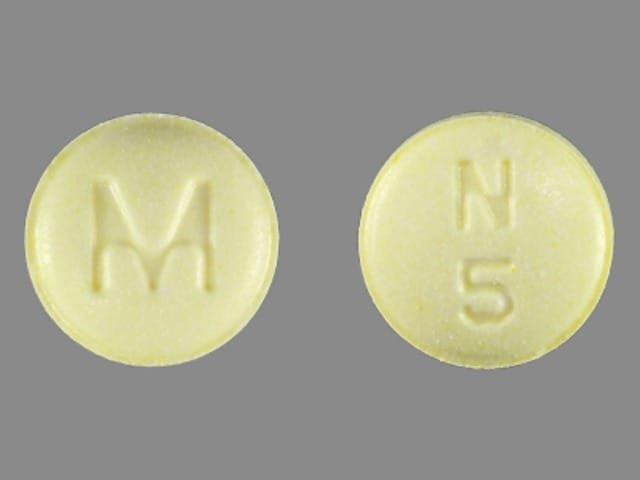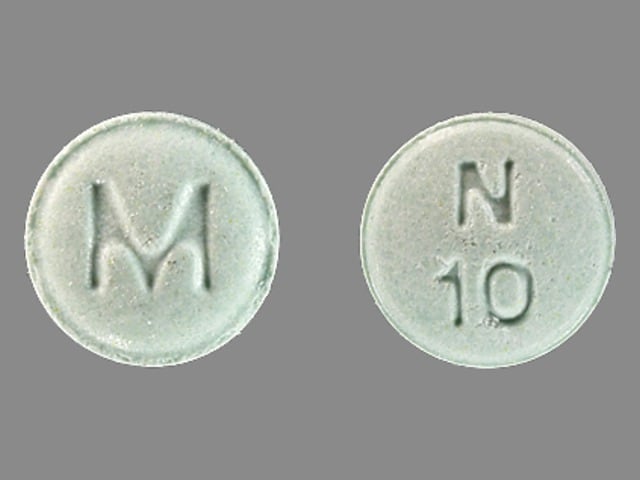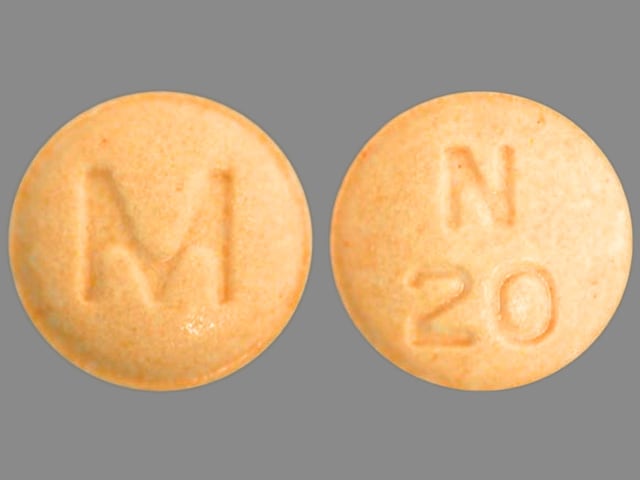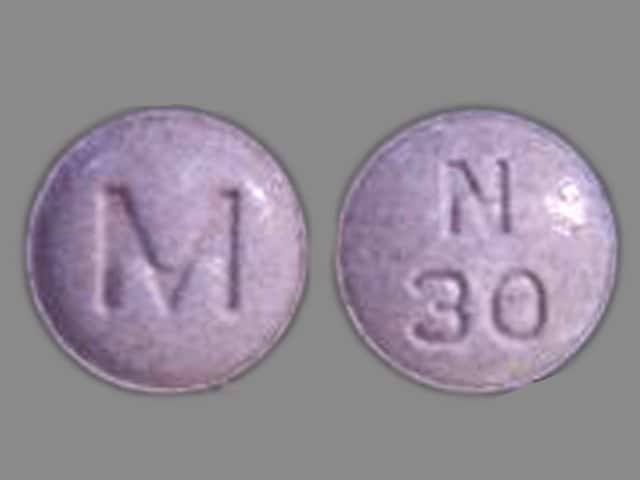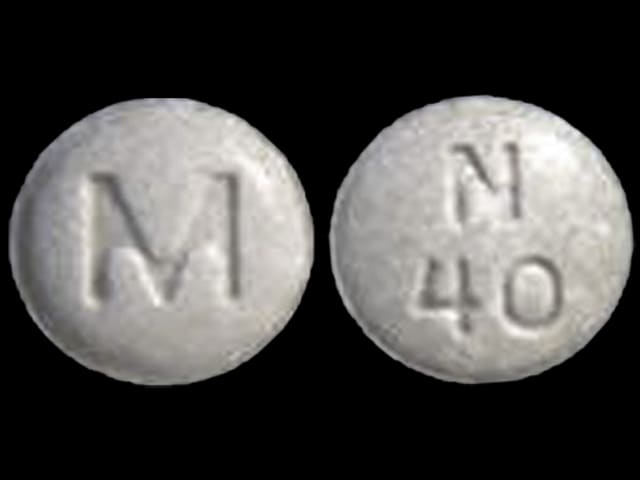Dosage Forms
Excipient information presented when available (limited, particularly for generics); consult specific product labeling. [DSC] = Discontinued product
Tablet, Oral:
Requip: 0.25 mg [DSC], 0.5 mg [DSC], 1 mg [DSC], 2 mg [DSC], 3 mg [DSC], 4 mg [DSC], 5 mg [DSC] [contains fd&c blue #2 aluminum lake, fd&c yellow #6 aluminum lake, polysorbate 80]
Generic: 0.25 mg, 0.5 mg, 1 mg, 2 mg, 3 mg, 4 mg, 5 mg
Tablet Extended Release 24 Hour, Oral:
Requip XL: 2 mg [DSC], 4 mg [DSC], 6 mg, 8 mg, 12 mg [contains fd&c blue #2 aluminum lake, fd&c yellow #6 aluminum lake]
Generic: 2 mg, 4 mg, 6 mg, 8 mg, 12 mg
Pharmacology
Mechanism of Action
Ropinirole has a high relative in vitro specificity and full intrinsic activity at the D2 and D3 dopamine receptor subtypes, binding with higher affinity to D3 than to D2 or D4 receptor subtypes; relevance of D3 receptor binding in Parkinson disease is unknown. Ropinirole has moderate in vitro affinity for opioid receptors. Ropinirole and its metabolites have negligible in vitro affinity for dopamine D1, 5-HT1, 5-HT2, benzodiazepine, GABA, muscarinic, alpha1-, alpha2-, and beta-adrenoreceptors. Although precise mechanism of action of ropinirole is unknown, it is believed to be due to stimulation of postsynaptic dopamine D2-type receptors within the caudate putamen in the brain. Ropinirole caused decreases in systolic and diastolic blood pressure at doses >0.25 mg. The mechanism of ropinirole-induced postural hypotension is believed to be due to D2-mediated blunting of the noradrenergic response to standing and subsequent decrease in peripheral vascular resistance.
Pharmacokinetics/Pharmacodynamics
Absorption
Immediate release: Rapid
Distribution
Vd: 7.5 L/kg
Metabolism
Extensively hepatic via CYP1A2 to inactive metabolites; first-pass effect
Excretion
Urine (<10% as unchanged drug, 60% as metabolites)
Time to Peak
Immediate release: ~1-2 hours; Extended release: 6-10 hours; Tmax increased by 2.5-3 hours when taken with a high-fat meal
Half-Life Elimination
~6 hours
Protein Binding
40%
Use in Specific Populations
Special Populations: Renal Function Impairment
Clearance of ropinirole was reduced by ~30% in patients with ESRD on dialysis
Special Populations: Hepatic Function Impairment
Patients with hepatic impairment may have higher plasma levels and lower clearance of ropinirole
Special Populations: Elderly
Oral clearance is reduced ~15% in patients >65 years
Special Populations Note
Cigarette smoking: Clearance is expected to increase because CYP1A2 is known to be induced by smoking. Cmax was 30% and AUC was 38% lower in smokers compared with nonsmokers.
Use: Labeled Indications
Parkinson disease: Treatment of Parkinson disease
Restless legs syndrome (immediate release only): Treatment of moderate to severe primary restless legs syndrome (RLS)
Contraindications
Hypersensitivity (eg, urticaria, angioedema, rash, pruritus) to ropinirole or any component of the formulation
Dosage and Administration
Dosing: Adult
Parkinson disease: Oral:
Immediate-release tablet: The dosage should be increased to achieve a maximum therapeutic effect, balanced against the principal side effects of nausea, dizziness, somnolence and dyskinesia. Recommended starting dose is 0.25 mg 3 times daily; based on individual patient response, the dosage should be titrated with weekly increments as described below:
- Week 1: 0.25 mg 3 times daily; total daily dose: 0.75 mg
- Week 2: 0.5 mg 3 times daily; total daily dose: 1.5 mg
- Week 3: 0.75 mg 3 times daily; total daily dose: 2.25 mg
- Week 4: 1 mg 3 times daily; total daily dose: 3 mg
Note: After week 4, if necessary, daily dosage may be increased by 1.5 mg/day on a weekly basis up to a dose of 9 mg/day, and then by up to 3 mg/day weekly to a total of 24 mg/day. If a significant interruption in therapy with ropinirole occurs, retitration may be warranted.
Parkinson disease discontinuation taper: Gradually taper over 7 days as follows: reduce frequency of administration from 3 times daily to twice daily for 4 days, then reduce to once daily for remaining 3 days.
Extended-release tablet: Initial: 2 mg once daily for 1 to 2 weeks, followed by increases of 2 mg/day at weekly or longer intervals based on therapeutic response and tolerability; there was no additional benefit shown for doses greater than 8 mg/day in advanced Parkinson disease or 12 mg/day in early Parkinson disease; maximum: 24 mg/day; Note: If a significant interruption in therapy with ropinirole occurs, retitration may be warranted. When discontinuing gradually taper over 7 days.
Restless legs syndrome: Oral: Immediate-release tablets: Initial: 0.25 mg once daily 1 to 3 hours before bedtime. Dose may be increased after 2 days to 0.5 mg daily, and after 7 days to 1 mg daily. Dose may be further titrated upward in 0.5 mg increments every week until reaching a daily dose of 3 mg during week 6. Daily dose may be increased to a maximum of 4 mg beginning week 7.
Note: If augmentation occurs, dose earlier in the day, divide into multiple daily doses, or consider switching to alternative therapy (Garcia-Borreguero 2016). If a significant interruption in therapy with ropinirole occurs, retitration may be warranted. Gradually taper dose if discontinuation is warranted.
Converting from ropinirole immediate-release tablets to ropinirole extended-release tablets: Choose a once daily extended-release dose that most closely matches current immediate-release daily dose.
Dosing: Geriatric
Titrate dose to clinical response. Refer to adult dosing.
Administration
Oral: Administer without regard to meals. Swallow extended-release tablet whole; do not crush, divide, or chew.
Storage
Store at 68°F to 77°F (20°C to 25°C). Protect from light.
ROPINIRole Images
Drug Interactions
Alcohol (Ethyl): May enhance the sedative effect of ROPINIRole. Monitor therapy
Alfuzosin: May enhance the hypotensive effect of Blood Pressure Lowering Agents. Monitor therapy
Alizapride: May diminish the therapeutic effect of Anti-Parkinson Agents (Dopamine Agonist). Avoid combination
Amifostine: Blood Pressure Lowering Agents may enhance the hypotensive effect of Amifostine. Management: When amifostine is used at chemotherapy doses, blood pressure lowering medications should be withheld for 24 hours prior to amifostine administration. If blood pressure lowering therapy cannot be withheld, amifostine should not be administered. Consider therapy modification
Amisulpride: May diminish the therapeutic effect of Anti-Parkinson Agents (Dopamine Agonist). Anti-Parkinson Agents (Dopamine Agonist) may diminish the therapeutic effect of Amisulpride. Avoid combination
Antipsychotic Agents (First Generation [Typical]): May diminish the therapeutic effect of Anti-Parkinson Agents (Dopamine Agonist). Anti-Parkinson Agents (Dopamine Agonist) may diminish the therapeutic effect of Antipsychotic Agents (First Generation [Typical]). Management: Avoid concomitant therapy if possible and monitor for decreased effects of both agents when these combinations cannot be avoided. Atypical antipsychotics such as clozapine and quetiapine may be less likely to reduce the effects of anti-Parkinson agents. Consider therapy modification
Antipsychotic Agents (Second Generation [Atypical]): May diminish the therapeutic effect of Anti-Parkinson Agents (Dopamine Agonist). Management: Consider using an alternative antipsychotic agent when possible in patients with Parkinson disease. If an atypical antipsychotic is necessary, consider using clozapine or quetiapine, which may convey the lowest interaction risk. Consider therapy modification
Blood Pressure Lowering Agents: May enhance the hypotensive effect of Hypotension-Associated Agents. Monitor therapy
Brimonidine (Topical): May enhance the hypotensive effect of Blood Pressure Lowering Agents. Monitor therapy
Broccoli: May decrease the serum concentration of CYP1A2 Substrates (High risk with Inducers). Monitor therapy
Bromopride: May diminish the therapeutic effect of Anti-Parkinson Agents (Dopamine Agonist). Monitor therapy
Bromperidol: Blood Pressure Lowering Agents may enhance the hypotensive effect of Bromperidol. Bromperidol may diminish the hypotensive effect of Blood Pressure Lowering Agents. Avoid combination
BuPROPion: Anti-Parkinson Agents (Dopamine Agonist) may enhance the adverse/toxic effect of BuPROPion. Monitor therapy
Cannabis: May decrease the serum concentration of CYP1A2 Substrates (High risk with Inducers). Monitor therapy
CNS Depressants: May enhance the sedative effect of ROPINIRole. Monitor therapy
CYP1A2 Inducers (Moderate): May decrease the serum concentration of ROPINIRole. Monitor therapy
CYP1A2 Inhibitors (Moderate): May increase the serum concentration of ROPINIRole. Monitor therapy
CYP1A2 Inhibitors (Strong): May increase the serum concentration of ROPINIRole. Monitor therapy
Diazoxide: May enhance the hypotensive effect of Blood Pressure Lowering Agents. Monitor therapy
DULoxetine: Blood Pressure Lowering Agents may enhance the hypotensive effect of DULoxetine. Monitor therapy
Estrogen Derivatives: May increase the serum concentration of ROPINIRole. Monitor therapy
Herbs (Hypotensive Properties): May enhance the hypotensive effect of Blood Pressure Lowering Agents. Monitor therapy
Hypotension-Associated Agents: Blood Pressure Lowering Agents may enhance the hypotensive effect of Hypotension-Associated Agents. Monitor therapy
Levodopa-Containing Products: Blood Pressure Lowering Agents may enhance the hypotensive effect of Levodopa-Containing Products. Monitor therapy
Lormetazepam: May enhance the hypotensive effect of Blood Pressure Lowering Agents. Monitor therapy
Methylphenidate: May enhance the adverse/toxic effect of Anti-Parkinson Agents (Dopamine Agonist). Monitor therapy
Metoclopramide: May diminish the therapeutic effect of Anti-Parkinson Agents (Dopamine Agonist). Monitor therapy
Molsidomine: May enhance the hypotensive effect of Blood Pressure Lowering Agents. Monitor therapy
Naftopidil: May enhance the hypotensive effect of Blood Pressure Lowering Agents. Monitor therapy
Nicergoline: May enhance the hypotensive effect of Blood Pressure Lowering Agents. Monitor therapy
Nicorandil: May enhance the hypotensive effect of Blood Pressure Lowering Agents. Monitor therapy
Nitroprusside: Blood Pressure Lowering Agents may enhance the hypotensive effect of Nitroprusside. Monitor therapy
Obinutuzumab: May enhance the hypotensive effect of Blood Pressure Lowering Agents. Management: Consider temporarily withholding blood pressure lowering medications beginning 12 hours prior to obinutuzumab infusion and continuing until 1 hour after the end of the infusion. Consider therapy modification
Pentoxifylline: May enhance the hypotensive effect of Blood Pressure Lowering Agents. Monitor therapy
Pholcodine: Blood Pressure Lowering Agents may enhance the hypotensive effect of Pholcodine. Monitor therapy
Phosphodiesterase 5 Inhibitors: May enhance the hypotensive effect of Blood Pressure Lowering Agents. Monitor therapy
Prostacyclin Analogues: May enhance the hypotensive effect of Blood Pressure Lowering Agents. Monitor therapy
Quinagolide: May enhance the hypotensive effect of Blood Pressure Lowering Agents. Monitor therapy
Solriamfetol: Anti-Parkinson Agents (Dopamine Agonist) may enhance the hypertensive effect of Solriamfetol. Monitor therapy
Sulpiride: May diminish the therapeutic effect of Anti-Parkinson Agents (Dopamine Agonist). Avoid combination
Tobacco (Smoked): May decrease the serum concentration of ROPINIRole. Monitor therapy
Adverse Reactions
Data inclusive of trials in early Parkinson disease (PD) without levodopa and restless legs syndrome (RLS). Extended-release data from trials in early PD without levodopa. As reported with immediate-release formulation, unless otherwise noted.
>10%:
Cardiovascular: Hypotension (RLS: ≤25%; PD: 2%), orthostatic hypotension (RLS: ≤25%; PD: 6%; extended release: 14%), hypertension (PD: 5%; extended release: 3% to 15%), syncope (PD: ≤12%; RLS: 1% to 2%; sometimes associated with bradycardia)
Central nervous system: Drowsiness (PD: ≤40%; extended release: 8% to 15%; RLS: 12%), dizziness (PD: 40%; extended release: 6% to 10%; RLS: 11%), headache (PD, extended release: 5% to 15%)
Gastrointestinal: Nausea (PD: 60%; RLS: 40%; extended release: 10% to 33%), vomiting (PD: 12%; extended release: 10%; RLS: 11%)
Infection: Viral infection (PD: 11%)
Neuromuscular & skeletal: Asthenia (PD: 16%; RLS: 9%), back pain (PD, extended release: 5% to 15%)
1% to 10%:
Cardiovascular: Lower extremity edema (PD: 7%), dependent edema (PD: 6%), chest pain (PD: 4%), flushing (PD: 3%), palpitations (PD: 3%), peripheral ischemia (PD: 3%), atrial fibrillation (PD: 2%), extrasystoles (PD: 2%), peripheral edema (RLS: 2%), tachycardia (PD: 2%)
Central nervous system: Pain (PD: 8%), confusion (PD: 5%), hallucination (PD: 5%), narcolepsy (PD, extended release: 5% to 10%), hypoesthesia (PD: 4%), amnesia (PD: 3%), paresthesia (RLS: 3%), yawning (PD: 3%), lack of concentration (PD: 2%), vertigo (2%)
Dermatologic: Diaphoresis (PD: 6%), hyperhidrosis (RLS: 3%)
Gastrointestinal: Dyspepsia (PD: 10%; RLS: 4%), abdominal pain (PD: 6% to 7%; includes immediate release and extended release), constipation (PD, extended release: 5%), diarrhea (RLS: 5%), xerostomia (PD: 5%; RLS: 3%), anorexia (PD: 4%), flatulence (PD: 3%), upper abdominal pain (RLS: 3%)
Genitourinary: Urinary tract infection (PD: 5%), impotence (PD: 3%)
Hepatic: Increased serum alkaline phosphatase (PD: 3%)
Infection: Influenza (RLS: 3%)
Neuromuscular & skeletal: Increased creatine phosphokinase in blood specimen (PD, extended release: 10%), arthralgia (RLS: 4%), limb pain (RLS: 3%), muscle cramps (RLS: 3%), hyperkinetic muscle activity (PD: 2%)
Ophthalmic: Visual disturbance (PD: 6%), eye disease (PD: 3%), xerophthalmia (PD: 2%)
Respiratory: Nasopharyngitis (RLS: 9%), pharyngitis (PD: 6%), rhinitis (PD: 4%), sinusitis (PD: 4%), bronchitis (PD: 3%), cough (RLS: 3%), dyspnea (PD: 3%), nasal congestion (RLS: 2%)
<1%: Pleural effusion
Postmarketing: Aggressive behavior, agitation, behavioral problems, delirium, delusion, disorientation, heart valve disease, impulse control disorder (Bastiaens 2013; Corvol 2018), interstitial pulmonary disease, mental status changes, paranoid ideation, pleuropulmonary fibrosis, psychiatric disturbance, psychosis
Warnings/Precautions
Concerns related to adverse effects:
- Dyskinesias: May cause and/or exacerbate dyskinesias. Use with caution in patients with preexisting dyskinesias. Decreasing the dose may alleviate this condition.
- Impulse control disorders: Has been associated with compulsive behaviors and/or loss of impulse control, which has manifested as pathological gambling, libido increases (hypersexuality), compulsive buying, binge or compulsive eating, and/or other intense urges. Dose reduction or discontinuation of therapy has been reported to reverse these behaviors in some, but not all cases.
- Melanoma: Risk for melanoma development is increased in Parkinson disease patients; drug causation or factors contributing to risk have not been established. Patients should be monitored closely and periodic skin examinations should be performed.
- Orthostatic hypotension: May cause orthostatic hypotension; Parkinson disease patients appear to have an impaired capacity to respond to a postural challenge. Use with caution in patients at risk of hypotension (such as those receiving antihypertensive or antiarrhythmic drugs) or where transient hypotensive episodes would be poorly tolerated (cardiovascular disease or cerebrovascular disease). Parkinson patients being treated with dopaminergic agonists ordinarily require careful monitoring for signs and symptoms of postural hypotension, especially during dose escalation, and should be informed of this risk. Syncope, sometimes associated with bradycardia, was observed in association with ropinirole in early Parkinson disease patients and patients with restless leg syndrome (RLS).
- Pleural/retroperitoneal fibrosis: Ergot-derived dopamine agonists have been associated with fibrotic complications (eg, pericarditis, retroperitoneal fibrosis, pleural effusion, pleural thickening, pulmonary infiltrates, cardiac valvulopathy). Although ropinirole is not an ergot, there have been postmarketing reports of possible fibrotic complications (pleural effusion, pleural fibrosis, interstitial lung disease, and cardiac valvulopathy) with ropinirole; monitor closely for signs and symptoms of fibrosis. Discontinuation of therapy may resolve complications, but not in all cases.
- Psychotic effects: May cause hallucinations, particularly in older patients. May also cause or exacerbate mental status and behavioral changes, which may be severe, including psychotic-like behavior during treatment or after starting or increasing the dose; manifestations may include paranoid ideation, delusions, hallucinations, confusion, psychotic-like behavior, disorientation, aggressive behavior, agitation, and delirium. Avoid use in patients with a major psychotic disorder.
- Retinal changes: Pathologic degenerative changes were observed in the retinas of albino rats during studies with this agent, but were not observed in the retinas of albino mice or in other species. The significance of these data for humans remains uncertain.
- Somnolence: Patients have reported falling asleep while engaging in activities of daily living; this has been reported to occur without significant warning signs; some of these events had been reported one year after the initiation of therapy. Ropinirole has also been associated with somnolence. Before initiating treatment, advise patients of the potential to develop drowsiness, and inquire about factors that may increase the risk (eg, concomitant sedating medications and/or alcohol, presence of sleep disorders, concomitant medications that increase pramipexole plasma levels). Patients must be cautioned about performing tasks which require mental alertness (eg, operating machinery or driving). Monitor for daytime somnolence or preexisting sleep disorder; discontinue if significant daytime sleepiness or episodes of falling asleep occur; if a decision is made to continue therapy, advise patients not to drive and to avoid other potentially dangerous activities.
Disease-related concerns:
- Cardiovascular disease: Use with caution in patients with cardiovascular disease because of a risk for elevation in blood pressure and changes in heart rate.
- Hepatic impairment: Use with caution in patients with hepatic impairment (extensively metabolized).
- Renal impairment: Dosage adjustment recommended in patients with ESRD on dialysis.
- Restless legs syndrome: Augmentation (earlier onset of symptoms in the evening/afternoon, increase and/or spread of symptoms to other extremities) may occur in some RLS patients. Risk factors for dopaminergic-induced augmentation include higher doses of dopaminergic agents, use of shorter-acting dopamine agonists (ie, pramipexole, ropinirole) or levodopa, low iron stores, and increased severity of symptoms prior to treatment initiation. To minimize risk of augmentation, treatment should only be initiated when symptoms significantly impact quality of life; intermittent treatment should also be considered. If dopaminergic agents are used as initial treatment, use the lowest effective dose and avoid exceeding recommended doses. If augmentation occurs, dose earlier in the day, divide into multiple daily doses, or consider switching to alternative therapy (Garcia-Borreguero 2016). End-of-dose rebound (reappearance of symptoms in the early morning hours) may also occur. Consider dosage adjustment or discontinuation of treatment if rebound symptoms occur.
Concurrent drug therapy issues:
- Drug-drug interactions: Potentially significant interactions may exist, requiring dose or frequency adjustment, additional monitoring, and/or selection of alternative therapy. Consult drug interactions database for more detailed information.
Special populations:
- Elderly: May be prone to an increased risk of adverse drug reactions.
Dosage form specific issues:
- Extended release: Extended-release ropinirole is designed to release medication over a 24-hour period. If rapid gastrointestinal transit occurs, there may be risk of incomplete release of medication and medication residue being passed in the stool.
Other warnings/precautions:
- Discontinuation of therapy: Taper gradually when discontinuing therapy; dopaminergic agents have been associated with a syndrome resembling neuroleptic malignant syndrome on abrupt withdrawal or significant dosage reduction after long-term use.
Monitoring Parameters
Blood pressure (orthostatic); daytime alertness; CNS depression, fall risk, behavior changes (eg, compulsive behaviors); periodic skin examinations
Pregnancy
Pregnancy Considerations
Information related to the use of ropinirole for the treatment of restless legs syndrome in pregnant women is limited. Current guidelines note that the available information is insufficient to make a recommendation for use in pregnant women (Aurora 2012; Dostal 2013; Tüfekçioğlu 2018).
Patient Education
What is this drug used for?
- It is used to treat Parkinson's disease.
- It is used to treat restless leg syndrome.
Frequently reported side effects of this drug
- Nausea
- Vomiting
- Constipation
- Diarrhea
- Fatigue
- Sweating a lot
- Abdominal pain
- Loss of strength and energy
- Stuffy nose
- Sore throat
- Back pain
- Tremors
- Dry mouth
- Joint pain
Other side effects of this drug: Talk with your doctor right away if you have any of these signs of:
- Urinary tract infection like blood in the urine, burning or painful urination, passing a lot of urine, fever, lower abdominal pain, or pelvic pain.
- Severe dizziness
- Passing out
- Confusion
- Uncontrollable urges
- Skin growths
- Mole changes
- Severe headache
- Severe anxiety
- Vision changes
- Chest pain
- Fast heartbeat
- Abnormal heartbeat
- Slow heartbeat
- Sensing things that seem real but are not
- Mood changes
- Behavioral changes
- Shortness of breath
- Abnormal movements
- Swelling of arms or legs
- Burning or numbness feeling
- Trouble with memory
- Difficulty focusing
- Stiff muscles
- Narcolepsy
- Signs of a significant reaction like wheezing; chest tightness; fever; itching; bad cough; blue skin color; seizures; or swelling of face, lips, tongue, or throat.
Note: This is not a comprehensive list of all side effects. Talk to your doctor if you have questions.
Consumer Information Use and Disclaimer: This information should not be used to decide whether or not to take this medicine or any other medicine. Only the healthcare provider has the knowledge and training to decide which medicines are right for a specific patient. This information does not endorse any medicine as safe, effective, or approved for treating any patient or health condition. This is only a brief summary of general information about this medicine. It does NOT include all information about the possible uses, directions, warnings, precautions, interactions, adverse effects, or risks that may apply to this medicine. This information is not specific medical advice and does not replace information you receive from the healthcare provider. You must talk with the healthcare provider for complete information about the risks and benefits of using this medicine.
